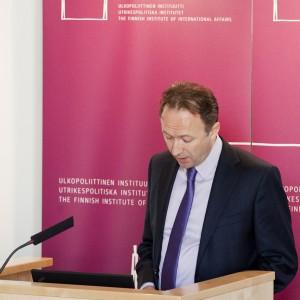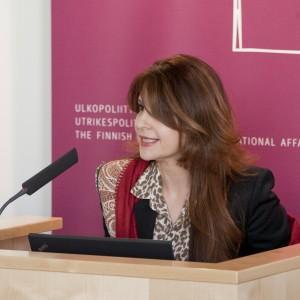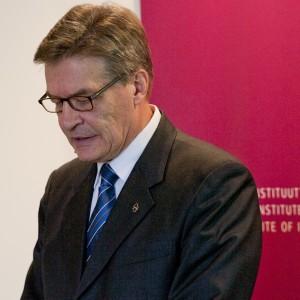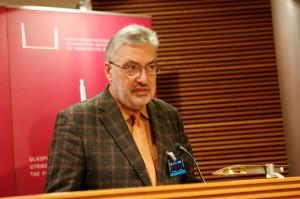The fate of Afghanistan is as always in the hands of its many leaders as well as some foreign actors. Yet, locals particularly in urban centers are seizing opportunities to make their dreams come to fruition and to build a better future. This can be seen from the diversity of local businesses to the fact that the country’s internal security is already in the hands of Afghans, with international support. This seminar will look beyond the 2014 presidential elections, and address regional and international repercussions of Afghanistan’s political development. How will the relationship between Afghan and foreign actors evolve as the international engagement will decrease in the second half of this decade? In particular, what will be the impact of Afghanistan’s post-2014 development on the wider South-Central Asian region? Furthermore, as the perspective of the international community will gradually shift from military security to development support, what lessons can be drawn from the experiences (and the mistakes) of the past decade? How can the international community ensure that its assistance is based on actual needs in the Afghan society?
Speakers:
”Post-2014 Afghanistan and its impact on South-Central Asia”
Dr Simbal Khan, Visiting Senior Researcher, TAPRI, the University of Tampere
Dr Khan is a security analyst and area studies specialist for the South-Central Asian region. She has extensive experience in research and analysis of regional security and other conflict-related policy issues. Her recent work has focused on the intersection between trans-border militant movements, terrorism, energy and regional politics. She has also focused on US-Pakistan-Afghanistan security dynamics.
”Afghanistan in 2015: A New Opportunity for the International Community?”
Dr Pauli Järvenpää, Senior Research Fellow, International Centre for Defence Studies (ICDS), Tallinn
Dr Järvenpää is a former high-level Finnish Defence Official and a Diplomat. After serving in the Ministry of Defence in 1983-2010, his last position being Director-General for Defence Policy (2001-2010), he was posted in 2010-2013 in Afghanistan as Finland’s Ambassador. Dr Järvenpää is currently Senior Research Fellow at the International Centre for Defence Studies (ICDS) in Tallinn, Estonia.
Comments:
Dr Olli Ruohomäki, Deputy Director for South Asia, the Ministry for Foreign Affairs
Dr Ruohomäki is currently the Deputy Director for South Asia at the Ministry for Foreign Affairs. He has worked in various capacities on the Afghanistan file for over a decade and travelled extensively in the country.
Chair: Dr Bart Gaens, Acting Programme Director, the Finnish Institute of International Affairs
Summary of the seminar
Acting program director Dr Bart Gaens from FIIA opened the seminar by introducing the seminar’s topic and the speakers shortly. He welcomed the speakers, Dr Simbal Khan and Dr Pauli Järvenpää and the expert commentator Dr Olli Ruohomäki. He also welcomed the audience, and then gave the floor to the first speaker, Dr Khan.
Dr Simbal Khan started by telling how pleased she is to have this opportunity to speak about her own region to an interested audience in Finland. The topic of Dr Khan’s presentation was the post-2014 Afghanistan and its impact on the South Central Asia. In the first section of her presentation, Dr Khan concentrated on the current situation in Afghanistan and on how the region is looking at it. She is specialized in security issues, so her presentation focused also on those.
Dr Khan stated that the last 13-14 years in Afghanistan have been years filled with war and conflict. There has been a contest of power between three forces that has been limited by each other. The three nodes on the triangle are the Afghan state, the Taliban and the international coalition. These three nodes have been holding a tight status quo in Afghanistan, and now the situation is changing, when most of the international troops will leave from Afghanistan by the end of 2014. What will be the changing dynamic? The question is will the two nodes, the Afghan state and the Taliban, be able to hold the status quo? The bordering states, Pakistan, Afghanistan, Uzbekistan, China, and even Iran, are skeptical about this. Conditions on the ground that allowed the Taliban to fight the Afghan state and the best militaries in the world for 14 years remain unchanged. There is a danger that the Taliban will still hold large areas of the state, and in a long run the state will be drifted to civil war and collapse. This view supports the ongoing political transition. This transition process is reinforced by the political reconciliation process with the Taliban; dialog with the Taliban might take place.
The opposing view states that the political reconciliation and the inclusion of Taliban are either unnecessary or pointless. For example India thinks that if this development is carried on, its presence in Afghanistan is threatened and it will be exploited by Pakistan. In this view, there are three main arguments: First, the Afghan state will be strong enough to fight the Taliban; second, the fighting will eventually cease, because nobody likes a situation where Afghans are fighting Afghans; and third, there is no need for a political reconciliation, because the system is already having the necessary features: free elections, political parties, other institutions etc.
As for the first assumption it can be argued that at the moment there are still 90 000 foreign forces in Afghanistan. The number of Taliban attacks has increased 47 % in one year 2012-13 and year 2013 has become the most violent year since the 2011. It seems almost that the Taliban is feeling the situation already in advance for the time when the foreign troops have left. The second assumption is that certain attacks will subside when the foreign troops leave. According to statistics, 75 % of the Taliban attacks are targeted against the Afghan National Security Forces, and not against the foreign forces. The war is now looking more and more like a civil war, and not anymore a defense war against foreign powers. The decrease of the attacks is not likely to happen. The third assumption is that the Afghan political system already provides a free framework for politics. There are organs of a democratic political system, such as free elections, political parties and other institutions etc. But the last ten years they have been juxtaposed to a top down patrimonial regime. The president has nominated all the people in the administration, and the system has been going down to the police officers and similar. This hybrid system has been working quite well the last 12 years, but there is a danger that it won’t do that anymore when the international forces withdraw and the security umbrella disappears. There are also other power brokers that have been out of the game and that now might want to enter it again.
In the second section of her presentation Dr Khan analyzed more the impact of Afghanistan to the South Central Asia region and the new trends of what will happen in Afghanistan after 2014. The first issue is the growth of the Afghanistan economic fueled by the foreign occupation and its impact to the neighboring countries. Also the reconstruction of Afghanistan, with help of the foreign actors, has profited the whole region of South Central Asia. The bilateral trade has increased very much from the 1990’s. The links are a new feature. For example, at the moment the official trade between Afghanistan and Pakistan is about 2 billion dollars per year, and the unofficial amount is about 5 billion. That is mostly in favor of Pakistan. Every day more than 100 000 Afghans cross over the border to go to Pakistan, either to work or to delivery etc., and 70 000 Pakistanis are employed in Afghanistan. Also India and China have invested great amounts to Afghanistan, especially to the mining business. The grater interaction has changed the patterns of political engagement. In the 1990s the bordering counties would have co-operation with different groups near the border. Now they interact also with the Afghan state itself (Kabul). This is a good step in the country-building process.
The last 14 years of war in Afghanistan have changed the security dynamics in the South Central Asia area. We can still talk about the spillover effect and the instability. When the foreign forces leave there will be a security vacuum that will be filled some way. The countries of the area are afraid that the jihadist organizations (IMU, IJU, etc.) would gain power. If there will be a civil war, the real danger is the refugees that would go for example to Pakistan and India. To conclude the second part of her presentation Dr Khan analyzed the positive and the negative factors of the situation after 2014. A very positive matter is that the surrounding countries now have a lot of interaction, diplomacy and trade with Afghanistan and Kabul. Many links and different platforms have been created. The negative aspect is that there is no regional infrastructure in the region, no common platform where to discuss common matters, but the actors are small groups.
Dr Pauli Järvenpää focused on the year 2015 in his presentation. He started by stating that there was a window open in 2002-2006 or even 2007, to do things right in Afghanistan. But this opportunity was lost. Why so? To answer that question, Dr Järvenpää first explained that we, the international community, used wrong tools; secondly, wrong tools were used wrong; and thirdly he analyzed what could be done now. He argued that the Afghan situation in 2015 can still turn out positively.
As a starting point Dr Järvenpää argued that the golden opportunity that we had in the beginning of 2000s was lost because the tools were military or used by the militaries. The military tried their best, as everybody involved tried their best. The military was also needed to give background security, but we should have invested also to the non-military tools to help the Afghans. There was of course a need to protect the civilians and eliminate uncertainty, but the more important issue would have been to establish a legitimate and accountable Afghan government. The Afghan government should have delivered essential human services, such as schools, health clinics, local governments and police forces. It should also have helped to improve the ancient agricultural methods to produce food to the people. Even today 25% of population is reliant on international food aid. There was also a burning need to support the gender rights at the time. There were some good results also, but the problem is that these results don’t show that much in the provinces and country side, where 75-80 % of the population lives. Good results are seen only in Kabul and a few other bigger cities. The foreign troops had very little understanding of the local customs, culture, languages or religion: they didn’t understand how powerful a force Islam is in Afghanistan.
The military rotations were very short: 6 or 12 months. It’s too short time to understand a different culture. Most of the military stayed inside the isolated bases, so they didn’t interact with the local people. There was never shortage of money or other resources: USA alone invested 150 billion dollars per year, and e.g. a small country like Finland 50 million dollars per year. The money wasn’t used wisely, as it produced dependencies. The police force and military are still highly dependent on the foreign advisers and experts and Afghans returning from diaspora. They are still paid differently than the normal civil servants, and it causes inequality in Afghanistan. 90 % of the Afghan government budget is covered by the international community. That causes very low visibility for the Afghan own government, and it also lost its credibility in the villages, where the people are. Many people, e.g. war lords and other power brokers, mishandled a lot of money meant to the development of the country, and corruption was part of everyday life.
What should be done from now on? We still have lots of money to use. It should be used in a better way than has been the case so far. At the NATO Chicago summit, 4 billion dollars were promised to Afghan National Security Forces, and another 4 billion in the Tokyo conference to civilian support. What would be the best way to use the money? Dr Järvenpää argued that at least there shouldn’t be more parallel structures and institutions created in Afghanistan. The Afghan actions and the Afghans in actions should be supported, and the Afghan accountability would follow that. The presidential elections in April 2014 will be very important. At the moment there are more than 30 candidates enrolled to the presidential elections. Other issues that the international coalition should support are education and training and the work and life in the villages. Nowadays 9 million students are in schools, of which 30 % girls. In Taliban regime there were only 200 000 boys at schools. Afghanistan is really missing skilled workers and the international coalition should support Afghanistan to build vocational schools and train teachers. The villages need support to better governance and new methods in agriculture. The unemployment rate is estimated to be as high as 60 to 65 % in the country side, and jobless young people are attracted by the Taliban and other groups as they haven’t got interesting things to do in life. Infrastructure development programs should also be supported: roads, airports, railways, pipelines, opening of the mines, etc. Dr Järvenpää’s last – and a difficult one – issue on the ”to do” –list was to somehow get Pakistan to play the game and shield the border so that the Taliban and other groups wouldn’t have such an easy access to a safe haven as they do now.
In his comment, Dr Olli Ruohomäki offered the audience some thoughts from his own experiences of Afghanistan. He has been in and out Afghanistan for the last decade, since 2002. He has talked with hundreds and hundreds of different people and travelled around the country. Dr Ruohomäki introduced an excellent book by Carter Malkasian that he had read recently, and that describes the situation in Afghanistan very well from one point of view. The book is entitled ”War comes to Garmser: 30 years of conflict on the Afghan frontier”. The most interesting thing in the book is that it describes well the life of the ordinary Afghans that try to build some kind of order out of the war. When the British and the Americans came and went, the Afghans stayed and carried on. The war has been murky, troublesome, messy and grey.
Dr Ruohomäki stated that the Afghanistan he had to get to know is a fragmented reality, the realities of different parts of the country are different, life in the villages and the cities differ a lot.
Dr Ruohomäki wanted to point out three issues of Afghanistan’s fragmented realities:
1) There is a long-standing fracture in Afghan society, the one of the tribes and the religious leaders.
2) There exists a strong competition between the various power brokers: tribe leaders, war lords and the government officials.
3) There is a very high tension between the center that is Kabul, and the provinces (the villages).
It’s very difficult to predict, how the tribal leaders will react to the post 2014-15 politics in Afghanistan and to whom they will shift their alliances.
To close his comment, Dr Ruohomäki chose ten words that capture the 2014-15 politics in Afghanistan: ”weak state institutions, and a lot of armed men around”.




